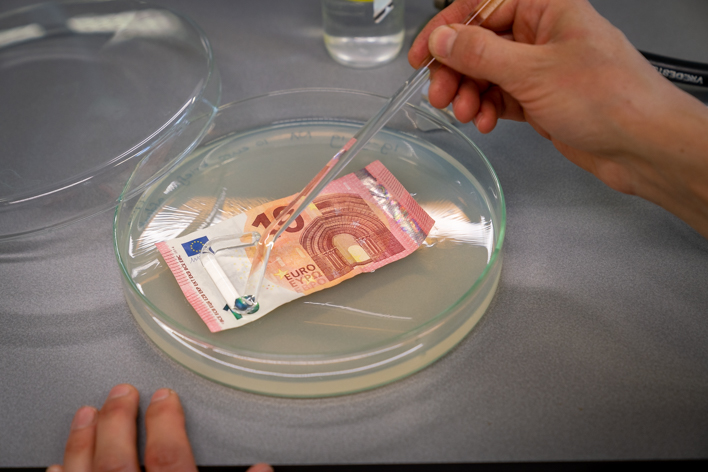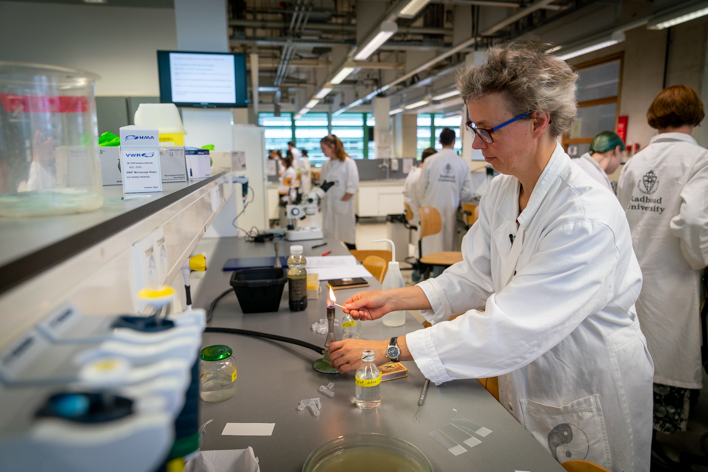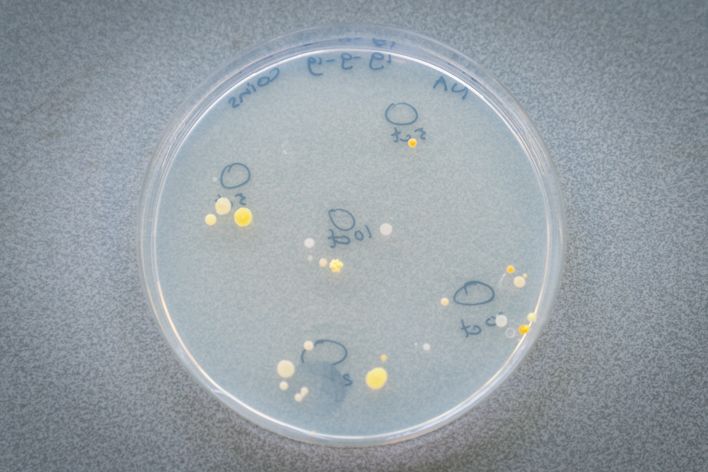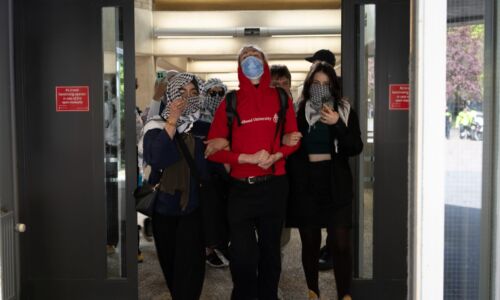How dirty is money?
Pecunia non olet – money doesn’t stink. Well, that remains to be seen. You’d think all those banknotes and euro coins passing from hand to hand can’t stay clean very long. Reason enough to pay a visit to the microbiology lab and submit our cash to a thorough inspection.
‘How many bacteria is that?’ Microbiologist Marjan Smeulders looks up from her microscope. ‘Billions.’ She says it as if it’s the most normal thing in the world. The computer screen linked to the microscope shows a fraction of the colony: hundreds of small transparent spheres, clumped together like microscopic soap suds. In reality the unappetising organisms are only a few micrometres in size – invisible to the naked eye. Magnified one thousand times they make a scary impression. And the source of this potential infection hotbed? A ten-euro note.
Money may not stink, but it’s certainly not clean. According to Nijmegen research, banknotes are an ideal breeding ground for pathogenic microbes like the faecal bacterium Escherichia coli (better known as E. coli) and MRSA – the infamous hospital bacterium that is resistant to many antibiotics. Last month, Professor of Infection Prevention Andreas Voss from Radboud university medical centre was awarded the famous Ig Nobel Prize, intended for improbable research, for this discovery.
Voss looked at sterile banknotes, which he’d infected in his lab with three pathogenic bacteria types. (Amusing detail: he conducted this experiment with his son, in the context of the latter’s secondary school profile paper). It may have been a neat study design from a scientific perspective, but it’s pretty unrealistic. After all, the banknotes in our wallets are far from sterile, and our environment is home to a multitude of bacteria types.
What microscopic organisms actually live on our euros, Vox wondered, and how dangerous is this?

Marjan Smeulders, researcher at the Microbiology Department of the Huygens Building, was willing to help. She’s in the middle of preparing a practical for second-year biologists, she explained, and has all the materials we need for our experiment at hand.
Turns out there’s more to it than pulling a ten-euro banknote out of your pocket and putting it under the microscope. If you do that, you won’t see anything. Bacteria are transparent, and therefore invisible on a coloured background. More importantly still: they are so small compared to the size of a banknote, it would be like looking for a needle in a haystack.
‘Within a day, you’ve got billions of bacteria’
Microbiologists adopt a smarter approach, which Smeulders demonstrates for our benefit. She’s prepared some petri dishes on the lab table in the practical hall. Three large ones (the size of a breakfast plate) and about ten smaller ones (beer mat size). Into each of these dishes, the microbiologist pours a layer of boiling hot golden liquid. ‘This liquid contains agar, a kind of binding agent, and nutrients that bacteria grow well on: sugars and especially proteins. You can eat it too, if you want.’ After about twenty minutes, the liquid has cooled down and congealed into a jelly.
The plan: we press our banknotes and coins into these sterile breeding grounds, leave them for a few minutes, and then remove them. The bacteria that stay behind in the agar jelly then start multiplying like crazy. Within a few days, this should result in colonies visible to the naked eye. Smeulders: ‘An E. coli bacterium cell divides every twenty minutes: 1-2-4-8-16, etc. Within a day, you’ve got billions of bacteria.’
To find out whether this is also true for our money – notes of ten and twenty euros and a few coins from our own wallet and that of a helpful lab assistant – we have to wait a little under a week. After the cash has been pressed in, the petri dishes are covered with a lid (so they don’t attract air-borne bacteria), and are placed by Smeulders in an oven at 30 degrees: ‘This helps them grow even faster’.
Poor hand hygiene
When the microbiologist takes our petri dishes out again – five days later – it is immediately apparent that our euros were anything but spotless. One of the dishes in which we pressed a ten-euro note and some coins is full of dots. There are dozens of these, varying in colour from white and light yellow to gold-orange and black. Most of the dots appear where the edges of the money touched the breeding ground. Smeulders: ‘These were the best points of contact between the coins and the growth medium.’
They look even more spectacular under the microscope. The yellow colony is found to consist of circular cells that cluster in groups of four. Typical of Micrococcus luteus, explains Smeulders excitedly. ‘I suspected it was this, because of the colour. Can you see how bright yellow it is? Wow! This is so exciting!’ Whether or not it’s really Micrococcus luteus, Smeulders can’t tell. She’d have to conduct a more extensive genetic study.

And the golden orange micro-organisms? They form the soap suds we mentioned earlier in this article, which consist of billions of individuals. Presumably a staphylococcus bacterium, says the microbiologist. ‘Probably Staphylococcus aureus. Aureus is Latin for gold.’ Hey, but isn’t that the little brother of the MRSA bacterium, the hospital bacterium that’s so difficult to control? ‘That’s right. This one can also lead to infection, for example if you scratch a wound. But normally speaking, your immune system shouldn’t have any problem dealing with it. It’s a perfectly normal bacterium, found on anyone’s skin.’
Plus, most skin bacteria are useful, she emphasises. ‘They clean up dead skin cells, and attack pathogens that end up on our hands when we touch something.’
Despite what the spectacular bacterial growth in our petri dishes suggests, the money we looked at was not particularly dirty, notes Smeulders. Each of the coins was home to less than ten microbes, and the banknotes housed no more than one hundred. ‘Actually, this money was quite clean. The fact that we now have billions of bacteria is only because we let them proliferate on a feeding dish.’
Intestinal bug
Professor of Infection Prevention Voss is not surprised by these low figures. ‘Bacteria don’t survive very long on banknotes. In our Ig Nobel study, 24 hours after infection, only a fraction of the bacteria remained. But it’s true that people sometimes pass their money on within 24 hours.’ He emphasises that the goal of the study was primarily to show that money may contain bacteria that can be transferred from person to person. ‘Even things that appear to be very clean, like a new banknote, or a pen, may contain pathogenic bacteria.’
Research shows that the main cause is poor hand hygiene. This summer, a study conducted by Utrecht University at the Zwarte Cross festival revealed that three quarters of the visitors had the faecal bacteria E. coli on their hands. Only half the Dutch population wash their hands with soap after using the toilet, concluded a survey by research agency Gallup a couple of years ago.
‘Maybe someone forgot to wash their hands’
What dirty hands can lead to becomes apparent in one of the larger petri dishes, which is covered with a large blurry grey patch. ‘A swarmer,’ concludes Smeulders. ‘A bacterium that can move. It means it can move across the agar plate.’

And indeed, under the microscope we can see rod-shaped bacteria swarming back and forth. The biologist can only tell us this is a soil bacterium, originating in soil and sand. According to Voss, it could also be an intestinal bug, like the Proteus bacterium. He laughs: ‘Maybe someone forgot to wash their hands properly.’
These bacteria are easier to pass on than you think, says Voss. ‘Most micro-organisms on money are in fact normal skin bacteria, and they’re usually harmless. But if you’ve got a cold or a Norovirus infection, it’s a different story. If you cough into your hands and hand someone a banknote, you can pass on the infection.’ If the other person rubs his hands in his eye or picks his nose, the germs can enter the body through the mucous membranes.
We are still somewhat confused. What conclusion should we draw from our lab study? All in all money seems to be far from clean, but should we avoid all cash payments so that we don’t get dirty hands? The two biologists agree that this would be overreacting. The likelihood of getting sick is after all very small. ‘Bacteria are unavoidable, they’re everywhere,’ says Voss. ‘But if you need to have really clean hands, for example for cooking, it’s important to wash your hands thoroughly with soap before you start.’
The new Vox, which is about money, can now be read online. Next week the English magazines will be spread around campus.



